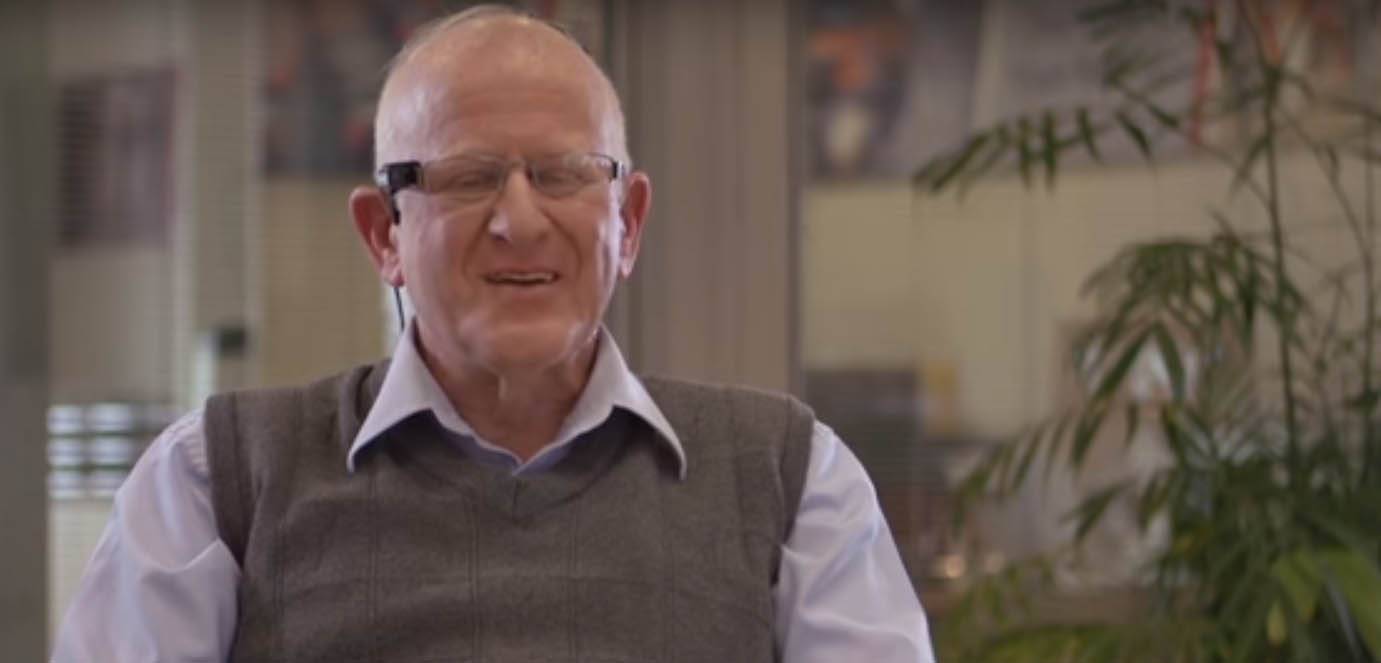
Getting Your Life On Track With Low Vision Glasses In St. Louis, Missouri
Low Vision doesn’t have to rob you of the things you enjoy, such as watching TV, reading, writing, driving, socializing, or simply playing with your grandchildren. If Low Vision has robbed you, or someone you love, of cherished activities and moments, a Low Vision aid or device can help!

Watch this video to discover more about how Bioptic telescopic glasses work.
Bioptic telescopic glasses are one of the most popular Low Vision glasses. They are designed as miniature binoculars above your line of sight in your eyeglasses. Simply lowering your chin slightly allows you to access the magnification needed to see objects.
- How Do Bioptic Telescopic Lenses Work?
They work by providing visual magnification and widening of the visual field. The higher the size of the telescope, the wider the range of view. The power of the telescope ranges from two to four times magnification. Telescopes at a four times magnification allow the patient to adjust the lens power as needed based on distance.
When fitting Bioptic Telescopic glasses, Dr. Jill Mogil is able to incorporate your existing prescription. The glasses that hold the telescope, known as the carrier lens, will be set at the same refraction as the patient’s regular glasses for vision at shorter distances. To see objects further out, all the patient needs to do is to tilt his or her head down a bit to look through the telescope.
- Bioptic Telescopic Lenses
The Bioptic Telescopic lens technology vastly outperforms alternative, less functional devices such as handheld and digital magnifiers. When it comes to improving quality of life, Bioptic Telescopic Lenses offer unmatched versatility and visual functionality.

E-Scoop Glasses are ideal for compensating for Low Vision arising from Macular Degeneration (ARMD). These glasses are specially designed to bridge the gap between regular glasses and telescopes. The glasses feature five basic components including:
- Lens Thickness — provides more magnification than regular glasses but less than that provided a telescope
- Prisms — adjustable strengths based on the patient’s needs
- Reflection-free Lenses (tints) — reduces glare
- Yellow or Amber tint—reduces high-contrast glare such as nighttime glare
- Base Curve of Lens
These five components are combined into the E-Scoop lens. They work seamlessly to create an enhanced image shifted to another part of the macula. With this, the patient is able to have enhanced vision that once was lost.
At the , we have seen that many Low Vision patients prefer the E-Scoop glasses as they look and feel more like regular glasses. The glasses provide the patient with improved distance vision during night driving, under bright light etc.

Full-diameter telescopes are designed for distance tasks that can be carried out while the wearer remains in place. Instead of a small bioptic lens on top of the glasses, this device covers the entire lens, the full diameter. They act almost like a binocular.
Full-diameter telescopes are suited for tasks where the wearer is mostly still and doesn’t need to move around. This includes:
- going to the theater
- making out people's faces
- watching TV
- viewing a sporting event
- or any other vision activity that doesn’t require moving around.
The full-diameter telescopes work best when viewing items that are between 10 and 15 feet away. These telescopes cannot be safely used for walking.

Tele-microscope glasses are helpful for mid-range and distance viewing. With this Low Vision aid, everything in your path will appear larger and easier to view. They are suited for activities such as:
- watching TV
- sporting events
- household chores,
- etc.
Tele-microscope glasses feature a seamless combination of two or three lenses, separated by a small gap of air. The telescope works by increasing the visual size of an image or object being viewed. They are also referred to as binocular telescopes.

Prismatic reading glasses are essentially extra strong reading glasses. The glasses are designed to allow for a natural, comfortable focal point. Prismatic reading glasses feature optical quality spherical lenses that magnify and converge the image at the same time. They are primarily useful as a reading aid.
Additionally, when worn for extended periods, the glasses can also help reduce eye fatigue. The Prismatic reading glasses help to improve convergence and minimize eye strain. If you need help with reading, our Low Vision optometrist, will fit the right prismatic reading glasses for you.

Side-Vision Awareness Glasses (SVAG) was designed to assist people suffering from side vision loss or hemianopsia. It is an effective optical field expansion device that can help patients missing part of their visual field to expand their awareness of objects in their path, enhancing peripheral vision.
SVAG feature a higher ABBE value. This helps to reduce distracting color aberrations seen by other lenses. SVAG also have the most extensive viewing area, thus, allowing better field awareness. These glasses feature more aesthetic lenses that are well suited for walking, reading, making out faces, etc. Many patients have successfully used these to drive.

Many Low Vision patients find it difficult to cope with excess light and glare, which reduces visual capacity. Absorptive Lenses are usually worn on top of prescription glasses. They reduce glare, eliminate harmful UV rays, heighten visual contrast, and control the transition between light and dark environments.
By regulating the quantity of light transmitted to your eye, absorptive lenses enhance visual comfort and safety. Absorptive lenses are often recommended to reduce glare under bright light or direct sunlight.

IrisVision is an affordable and effective tool for overcoming the challenges of Macular Degeneration. This wearable device features advanced virtual reality technology and provides up to 70-degree field of view.
IrisVision allows patients to see the world more clearly and fully. The device also comes with multiple view modes. For example, patients can use “TV Mode” to watch television and “Reading Mode” for reading text. For general viewing, the patient can simply switch to “Scene Mode”.

OrCam is a groundbreaking device that is changing how people with Low Vision can view the world. It is a tiny device that can be clipped to your eyeglasses. The OrCam features a camera, speaker and a cable connected to a larger device. Making use of Artificial Intelligence (AI) software, the OrCam helps the wearer to read text, identify products, recognize faces, and more by reading or announcing information the camera interprets.
What Is Low Vision?
Low Vision refers to visual impairments which cannot be corrected using traditional eye correction techniques such as standard glasses, contact lenses, medicine, or surgery. It can be a result of eye injury, eye conditions such as macular degeneration, or other factors such as age. Having Low Vision means it is difficult, if not impossible, for patients to perform everyday ordinary activities such as driving or even reading. Sadly, all too often patients are told that there is nothing to be done, resulting in a loss of hope in addition to the loss of daily ability to function.
CLEAR IMAGE PRISMATIC READER
E-SCOOP MEN'S FRAME, ORANGE LENS
FULL DIAMETER TELESCOPE GLASSES
E-SCOOP WOMEN'S FRAME, YELLOW LENS
ONE PIECE PRISMATIC MICROSCOPE
LOWER POWER TELESCOPE GLASSES
SIDE VISION AWARENESS GLASSES
BIOPTIC LENSES
Low Vision glasses can help restore your independence. At Gateway Low Vision, we custom fit state-of-the-art devices that improve visual functionality for patients suffering from Low Vision. Whether you are unable to read, recognize faces, drive, or simply go about your daily life, a Low Vision Aid can drastically improve your quality of life for the better.
Low Vision aids and devices help you visually circumvent the day-to-day challenges of eye conditions such as macular degeneration, diabetes, diabetic retinopathy, glaucoma, and retinitis pigmentosa. The success of these devices is well-documented. You or your loved one will be able to see for themselves.
With the help of these innovative vision aids, magnifiers, glasses, devices, and other technologies, Dr. Jill Mogil of Gateway Low Vision has been able to help patients, both young and old in Missouri overcome the limitations of Low Vision for years.
Low Vision glasses and devices work by utilizing and maximizing whatever vision remains. By significantly enhancing and directing the vision you still have, Low Vision glasses, aids or devices allow the wearer to regain the specific vision functions that have been lost. Low Vision glasses and devices come in a wide range of designs and powers.
They range from simple handheld magnifying lenses to advanced electronic device to state-of-the-art telescope glasses and more. Dr. Jill Mogil will ensure that the recommendations are personalized to meet your specific condition as well as lifestyle needs and diverse visual requirements. Our low vision doctor helps patients from St. Louis, Eastern Missouri, Jefferson City, Poplar Bluff, and the state of Missouri find the ideal low vision devices for their needs.
Most Low Vision devices are categorized as either optical, electronic, or non-optical. Each device type is geared towards different visual tasks.
At Gateway Low Vision, our Low Vision doctor, Dr. Jill Mogil will begin by first assessing the severity and specific limitations arising from your Low Vision condition. Once that determination is made, you will be scheduled for a 60 - 90 minute Low Vision Evaluation. This helps to determine the extent of your vision loss, the affected parts of your visual field and whether it’s central or peripheral. Dr. Jill Mogil will then recommend a suitable Low Vision aid or device.
Patients visit us for low vision devices from St. Louis, Eastern Missouri, Jefferson City, Poplar Bluff, and the state of Missouri. Here are some of the Low Vision Devices that the can fit you with.
Other Low Vision Aids
Today, computers are essential to how we communicate, learn information, and engage with the world. However, they pose problems for people suffering from Low Vision, primarily due to issues relating to resolution, contrast, size, etc.
Fortunately, there are advanced programs designed for Low Vision and the Visually Impaired which adjust the visual output of the computer to compensate for these problem. Low Vision software includes JAWS Screen Reader and MaxiAids, amongst others.
Also referred to as closed-circuit television (CCTV), video magnifiers make use of a handheld or stand-mounted camera to enlarge and project an image onto a screen. These video magnifiers often feature cameras. The zoom lens of the camera will determine the level of magnification and focus. Video magnifiers are useful when distinguishing between colors is crucial. This can include maps, color photographs, and so forth.
The CCTV consist of camera, viewing screen or monitor, mount arm for camera, and lenses for zooming. Viewing modes with color, lighting, and contrast helps to provide an improved vision.
By making use of the CCTV, patients can carry out various tasks such as reading books, writing, playing a crossword puzzle, connectivity to a computer and so forth. When you visit our eye care facility, our Low Vision doctor, Dr. Jill Mogil, will recommend the suitable CCTV for you.
Handheld magnifiers are portable devices that can help to magnify objects. They can increase image size between 1.5 – 20 times. For convenience, you can simply tuck the magnifier into your pocket or purse. Some feature battery-powered lights. Handheld magnifiers can help Low Visions patients to enhance their reading and viewing ability.
The stand magnifier is a plus lens mounted on a stand. The lens magnifies objects between 2-20 times. The majority of stand magnifiers now feature built-in lights that provide excellent illumination. Stand magnifiers are an excellent option for reading.
Get Your Life Back. Contact Us For Low Vision Glasses, Aids And Devices In Missouri
Gateway Low Vision provides Missouri with Low Vision aids and devices that can drastically improve you or your loved one’s ability to cope and thrive day-to-day. Contact us to discuss your options for reclaiming your vision and your life.


